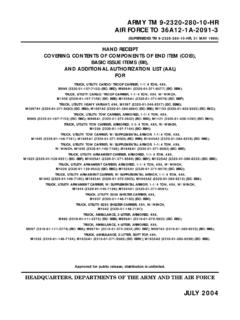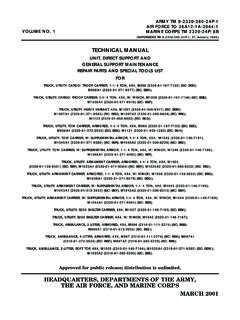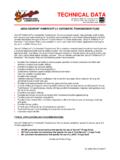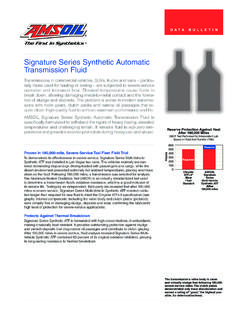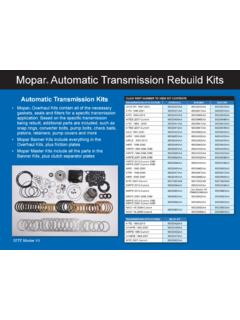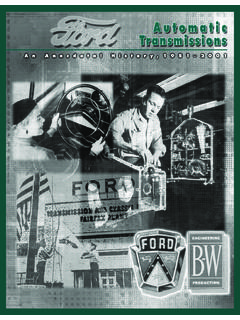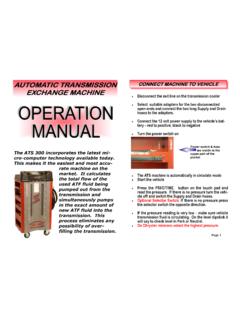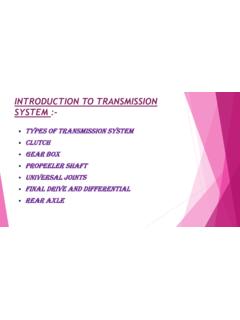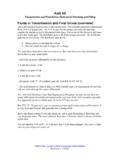Transcription of Automatic Transmission Fluid Overheating: New …
1 REC Newsnote #15 December 2005. Automatic Transmission Fluid overheating : New Jersey Forest Fire Service's Solution to High Temperature Problems in Ford F-350 and F-450. Roscommon Equipment Center National Association of State Foresters in Cooperation with Michigan's Forest Fire Experiment Station Until recently, manual transmissions were the norm for interfering with the operation of the Transmission . Above most wildfire control trucks. Automatic transmissions have 250oF., rubber seals harden, leading to pressure loss and a wide acceptance now for several reasons. A major leaks. Also, the Transmission can slip. In the worst cases, advantage is the shorter learning curve for new operators. clutches fail and costly repairs result. Also, some agencies have started using their wildland fire engines to tow trailers hauling other equipment. The ATF manufacturers suggest that for every 20oF.
2 Increase Automatic allows for greater start up torque and smoother in operating temperature above 175oF., the life of the Fluid shifting when towing. Oil is used to shift gears in the is cut in half. Hence at 195oF., oil life will be about 50,000. Automatic Transmission . The friction losses of this process miles. Above 240oF., it becomes nil. Without adequate heat the Transmission Fluid . Under certain operations, cooling, the heavy duty use of wildland fire engines will such as towing heavy loads, the oil temperatures may likely push the ATF operating temperature very high. reach a point where the oil will break down. When this occurs, the result is a damaged Transmission or a shorter Monitoring and Reducing ATF Temperature life for one. It is important to design the Transmission Driving conditions determine the likelihood of generating cooling system for these heavy-duty applications.
3 This high ATF temperature. These include trailer towing, report discusses the Transmission heat problems and climbing hills or mountains, stop-and-go driving, repeated potential solutions for preventing its occurrence. drive-to-reverse shifting, and high ambient operating temperatures. Any of these are common to wildfire Automatic Transmission Basics fighting. Since the vehicle's cooling system helps to cool The Transmission connects to the back of the engine and the Transmission Fluid , low coolant levels and dirty directs the engine's power to the drive wheels. A truck radiators can add to the problem. High ATF temperature engine runs best within a certain RPM (revolutions per will add heat to your radiator, possibly overheating the minute) range. The gear combinations of the Transmission engine coolant. Many new truck models have a allow power to be delivered to the wheels while keeping Transmission oil temperature gauge installed as a standard the engine within that range.
4 To change gears, the engine feature. If your truck does not and you suspect that the is temporarily disconnected from the vehicle. A manual Fluid is getting too hot during operation, consider adding Transmission does this by physically separating two clutch an after-market temperature sensor and gauge. plates when the operator depresses the clutch pedal. When the clutch pedal is released, the friction between the Select optimum gear ratios when ordering the vehicle. plates forms a direct drive link with very little loss of There are several ways for reducing this ATF overheating . efficiency. One is to order the proper gear ratios when purchasing the truck. Optimum gearing reduces heat produced. You An Automatic Transmission accomplishes the gear shift need to determine the projected use for the truck. Then using a complicated set of components that use oil flow find a knowledgeable source for selecting the best ratios acting on turbine blades.
5 During this process, heat is available for the truck models that fit your need. If you generated from the friction of the Fluid churning inside the have noone capable within your agency, talk to the truck torque converter as well as friction created from manufacturers. They have advisors within their sales movements of clutch plates, gears, and bearings. Cooling force to help. It is also good to use their expertise as a of Transmission Fluid is critical. Normally, the oil is double check. In any case, the most efficient gear ratios circulated to a heat exchanger in the lower radiator. for both the Transmission and axle are determined by how Under harsher conditions, auxiliary cooling is necessary. you use your truck and this in turn decides how much work your Transmission will do. Automatic Transmission Fluid Temperature Automatic Transmission Fluid (ATF) has a life of about Adding increased cooling with a different oil pan.
6 A. 100,000 miles at 175oF. At high temperatures, it oxidizes, supply of Transmission oil is stored in its sump or oil pan. turns from red to brown and exhibits a burnt smell. In Some heat dissipation occurs as the oil sits here, waiting addition to reducing the oil's lubricating quality, high to be pumped back through the system to the temperature produces a varnish on internal parts Transmission . There may be an after-market Transmission 1. pan available for the truck that helps reduce oil high temperatures were likely the result of driving with temperature. Usually these work in two ways. Most are constant, heavy loads. The manufacturer's representative larger than the original pan which adds more oil capacity and the dealer suggested the installation of an additional and thus more oil to absorb the heat. Some are made of inline, auxiliary ATF cooler.
7 NJFFS selected a Flex-a-Lite aluminum which conducts heat quickly, exchanging more model #45951 cooler. It has a built-in thermostatically of it to the air. Additionally, fins increase the surface area controlled electric fan that they set at 200oF. The unit was enhancing heat exchange. This is a relatively low cost mounted just in front of the radiator, in a place chosen to way to achieve some reduction in oil temperature. Before provide sufficient airflow for proper cooling yet still be trying this option, check to see if the new pan affects protected from potential brush coming up from the ground clearance adversely. undercarriage. The hoses connecting the cooler needed to be protected as well. Adding an external ATF cooler. This is the most common and effiecient way to gain additional cooling. Figure 1 shows a flow diagram for the ATF system before Auxiliary coolers are heat exchangers that are readily addition of the second auxiliary cooler.
8 Under normal available as they are often added to motorhomes and operating conditions, ATF flows from the outlet port at the trucks used to tow trailers. Usually the cooler is added in front of the Transmission , to the heat exchanger located in front of the vehicle's radiator. The Transmission oil is the radiator, and then to the factory-mounted auxiliary routed to the new heat exchanger after leaving the factory- cooler. From here, the cooled Fluid returns through an installed cooler located in the radiator. It then returns to inlet port located at the rear of the Transmission . A. the Transmission . A fan can be added to increase air flow temperature controlled valve and recirculation line is through the exchanger, thus adding more cooling located at the Transmission outlet port. When the Fluid is capacity. cold, this valve is open and the Fluid travels directly back to the Transmission via the bypass tube rather than It is important to select an ATF cooler that has enough through the coolers.
9 Heat exchange capacity for your use. There are many shops which install these devices should your agency not Figure 1. Factory ATF line have the capability. They should be able to help select routing of NJFFS truck.. ux the proper cooler. Use the words Transmission oil r yA r cto ole cooler with a good internet search engine and a number Rad iator Fa Co Tra nsmission TF. of potential suppliers will appear. Most have a guide to A. help in selecting the right cooler. The New Jersey Forest Fire Service (NJFFS) used this method to solve ATF. temperature problems with their Ford Super-Duty vehicles. Bypass er ool The following describes the step-by-step process open when c old C. F. performed in the NJFFS shops. While Ford trucks are AT. used in the example, the method could be used with other vehicles as well. Adding a Heat Exchanger to a Truck Figure 2 shows the ATF flow diagram after NJFFS added The NJFFS found that, under their use conditions, the the additional ATF cooler.
10 This new cooler was added Transmission oil temperature exceeded the recommended downstream from the factory installed cooler. By doing maximum for their Ford F-350 and F-450 chassis, Type 6x this, the auxiliary cooler fan does not have to run as often. wildland fire engines. NJFFS engines are equipped to Also note that they removed the bypass tube (Figure 4). work off-road and have brush guards to withstand which was mounted on the right side of the Transmission knocking down brush and small trees. This allows them to with two bolts. Doing this causes the ATF to circulate drive to the fire and keep it small. The vehicles had an through the coolers at engine startup. This delays the auxiliary engine driven water pump, hose reel, utility body, steel reinforcement and 250-gallon water tank. The Figure 2. ATF line routing after NJFFS adds another operating vehicle weight of the F-350 and F-450 engines.

